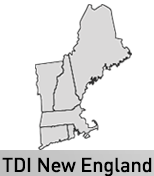Q&A
Q: What is HVdc Transmission?
A: High Voltage direct current (HVdc) energy transmission is a time-tested technology that transmits power over long distances more efficiently than Alternating Current (AC) transmission. Learn more.
Q: What is the project route?
A: The proposed route would start at the U.S.-Canadian border, travel south through Lake Champlain, move onto land using public rights-of-way wherever possible and end at a converter station that will be built in Ludlow, Vermont.
View a map of the preferred route.
Q: How will this project affect the environment?
A: Placing these cables, which are only five inches in diameter, underwater and underground will be minimally invasive to the surrounding environment and preserve natural views. The cable is solid state and compact, further minimizing risks to the environment.
Q: How will the cable be installed?
A: The cable will be installed using low-impact technology that minimally affects the environment. View a demonstration video of how cable is installed using water-jet technology.
Q: Will this project use overhead transmission lines?
A: No. The cable will either be placed in existing waterways or buried underground. There will be no new overhead transmission lines associated with this project.
Q: What happens if a line is cut or broken — will the water become electrified?
A: If the cable is damaged, HVdc protection reduces the current and voltage to zero in a fraction of a second so there is no possibility of damage to persons, fish, or any nearby infrastructure.
Q: What precautions will be taken to protect the cable once it is in the water? Can anchors from boats snag it?
A: The cables will be buried below the bottom of Lake Champlain or in deeper depths laid on the bottom to protect against an anchor or fishing equipment snagging the cable. In the unlikely event that the cable is snagged, given the weight of the cable, the boat that snagged the cable will immediately know that it is attached to a major subsurface feature. There will be both fiber-optic and communications protection on the equipment that will detect such a snag, as well as fault-protection equipment at both converter stations to clear any fault very quickly. The cable protection equipment is designed to shut down operation in order to protect life and equipment in the very unlikely event that the cable becomes damaged by external equipment.
Q: Who is financing this project?
A: The project will be financed by the private sector. The lead investor is the Blackstone Group, a leader in alternative asset management with over $387 billion under management as of September 30, 2017. Blackstone specializes in private equity and has emerged as one of the largest private equity firms in the world.
Q: As a rate-paying utility customer, will I be required to pick up the costs of the project though my utility bill?
A: The project is being developed as a merchant line, meaning the risks associated with developing and constructing it fall with the developer and not Vermont’s ratepayers. The cost of the line will not be added to any electric delivery charges paid by New England ratepayers.
Q: Where is this new power coming from?
A: This project will bring new and existing sources of clean energy from Canada to help meet the growing needs of the New England market. This line is expected to be used primarily by renewable generators in Canada who will contract for long-term space on the line to deliver their energy to the New England market.
Q: Where is the power going?
A: The power will be delivered to a converter station that will connect to the Vermont Electric Power Company (VELCO) system. That system is connected to the broader New England market that is operated by ISO-NE, the independent system operator for New England.
Q: How will it affect electric rates?
A: The project is expected to lower wholesale market prices for electricity in the New England market by approximately $1.6 billion over the first 10 years it is in service, according to recent economic studies performed by Levitan & Associates, Inc.
Q: Does the government approve this project? What approvals are needed?
A: The project is subject to thorough state and federal governmental reviews and permitting, as detailed here. As of early 2017, the Project had received all material permits required for construction.
Q: Will the public have a chance to participate in the process?
A: Yes. In addition to the public participation that is required under state and federal permitting processes, an extensive outreach program to the public will occur.
Q: Has this type of project been done before? Is it safe to put electric cables in water?
A: Underwater HVdc cables are in operation all over the world. For example, the Neptune project in New York Harbor, an underwater HVdc cable connecting New Jersey and Long Island, has recently gone into service. Burying cables along natural waterways is both cost effective and esthetically benign. The same development team is also developing a similar project in New York, the Champlain Hudson Power Express.
Q: How long do these lines stay in operation?
A: There are many examples of these projects in operation for more than 50 years. The converter stations will have periodic maintenance performed on transformers and other electrical equipment as specified by the manufacturer. The cables are monitored on a continuous basis and, unless damage is detected, they are virtually maintenance-free.
Q: Is this a safe project?
A: Yes, this is a very safe project. The HVdc cables that will be used for this project are solid, made from non-flammable materials, are well insulated and do not contain liquids or gels. The HVdc converter stations are solid state and contain no flammable fuel, as compared with thermal generation stations. Electrical protection systems within the HVdc converter stations will isolate any fault in a small fraction of a second to minimize the possibility of damage.
Q: Will the project affect the commercial and recreational use of Lake Champlain?
A: No. The current and future use of the lake will be unaffected.
Q: What maintenance needs to be done on the lines?
A: The cables are monitored on a continuous basis and, unless damage is detected, they are virtually maintenance-free. The converter stations will have periodic maintenance performed on transformers and other electrical equipment as specified by the manufacturer.
Q: Is there any testing that will need to be done in waterways to make sure the lines can be placed in them?
A: TDI New England will complete many environmental tests where the lines will be placed. These include a side scan sonar analysis and bottom sampling of the lake where the project will be located.
Q: Is there a need for this project?
A: Yes. The New England governors are actively exploring ways to reduce greenhouse gases and this project will do that. In addition, New England has experienced, or shortly will experience, the retirement of nuclear and coal generating facilities. In 2017, the State of Massachusetts put out an RFP for 9.45 TWh of clean energy. TDI-NE and its energy partners responded to this RFP in July, 2017.
Q: What voltage level will the project operate at?
A: The project will operate at between 300–320 kV, depending upon the technology that is selected.
Q: I don't live near the line, will I see any benefit from this project?
A: Yes. An overview of the benefits for Vermonters can be found in testimony submitted to the VT PSB.
Q: Will the converter station interfere with radio frequency signals?
A: No, it will not. The electromagnetic field around an HVDC Light converter installation is low, since all apparatus is located in a building designed to provide a very efficient shield. The shielding is provided in compliance of all radio frequents (RF) guidelines for interference. The detailed design considers proper mitigation of radio interference and corresponding fields that might cause radio interference.




